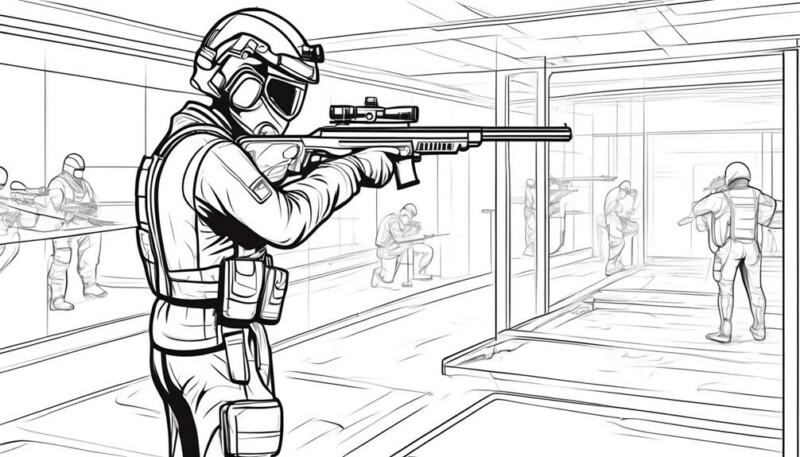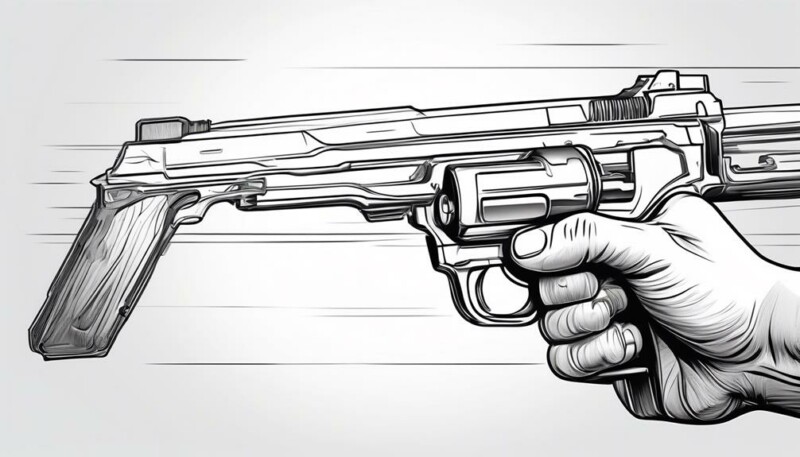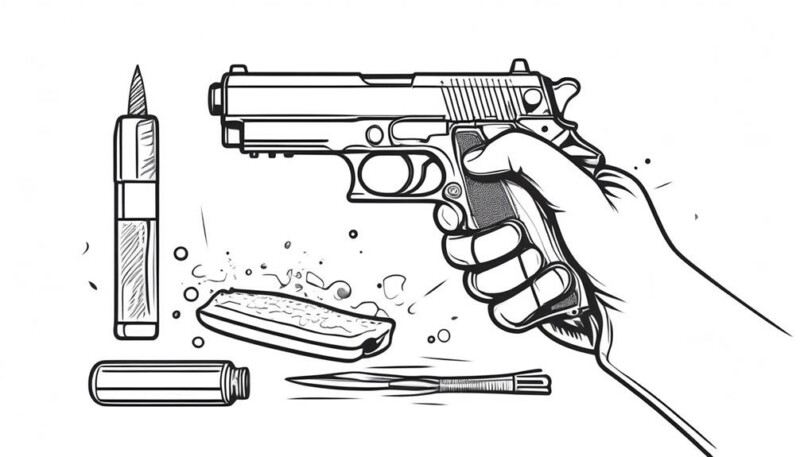Imagine you've just purchased your first firearm, a new world filled with responsibility and precision opens up before you. It's essential to get familiar with the ins and outs of gun safety, a non-negotiable part of owning a firearm.
You're not alone in this journey; countless beginners have walked this path before. We've distilled their wisdom and experience into ten fundamental firearm safety tips that will equip you to handle your new tool with respect and caution.
Keep in mind, this is just a starting point; there's a wealth of knowledge and proficiency waiting to be discovered. So, are you ready to embark on this critical journey towards becoming a responsible firearm owner?
Key Takeaways
- Always keep your firearm pointed in a safe direction and never point it at anything you don't intend to shoot.
- Treat every gun as if it can fire at any time and don't rely solely on the safety mechanism of your firearm.
- Thoroughly assess your target and surroundings before firing, considering potential bullet paths and bystanders.
- Select proper ammunition that matches your firearm's specifications, store it securely, and regularly inspect it for damage or corrosion.
Understanding Safe Muzzle Direction
Ever wondered where to point your gun when handling it safely? Understanding safe muzzle direction is the answer. Always remember, firearm safety ALWAYS comes first. This means keeping your firearm pointed in a safe direction at all times, a fundamental rule of gun safety.
Never point your gun at anything you don't intend to shoot. This might seem obvious, but it's an easy mistake to make, especially for beginners. So, be mindful and keep that finger away from the trigger until you're ready to fire.
Consideration of possible ricochets and penetration is also vital when determining a safe direction. Bullets can bounce off hard surfaces or penetrate through walls and still cause harm. So, be aware of your surroundings and the possible implications of a misplaced shot.
Most importantly, remember that you're in control of the muzzle's direction. Even if you stumble or fall, it's crucial to maintain control and keep it pointing in a safe direction. This responsibility is yours alone. It's a key component of gun handling, and taking it seriously can prevent accidents.
Unloading Firearms When Unused
Building on the importance of controlling your firearm's direction, another pivotal aspect of gun safety is ensuring that your firearms are unloaded when they're not in use. This is one of the fundamental firearm safety tips for beginners that shouldn't be overlooked.
Unloading firearms when unused is an essential part of safe gun handling. It's all too easy to forget whether you've loaded or unloaded your gun, especially if you're a beginner. That's why it's crucial to make this step a habit. Every time you finish using your firearm, unload it. This reduces the risk of accidental discharge, protecting you and those around you.
To unload your firearm, ensure you're pointing it in a safe direction, remove the magazine if there's one, and then clear the chamber. Remember, always treat your firearm as if it's loaded, even when you think it's not.
Incorporate this safety tip into your routine. It's not just about being responsible; it's about keeping yourself and others safe. Remember, safety should always be your priority when handling firearms.
Don't forget to unload your guns when they're not in use. Your life and the lives of those around you may depend on it.
Importance of Not Relying on Gun Safety
While your firearm's safety mechanism plays a crucial role, it's important not to let your guard down and solely rely on it for your protection. The first rule of gun safety rules is to treat every gun as if it can fire at any time, regardless of its safety mechanism. Don't assume a gun is unloaded, always visually check and handle it with care.
Remember, safety ALWAYS comes first. It's your responsibility to handle guns safely, not just depend on safety devices. Remember that accidents can occur if you're not alert or if you become too complacent. Never point the gun at anything you don't intend to shoot, even if you believe it's not loaded or the safety is on.
Even if your gun has the most advanced safety mechanisms, it won't replace your vigilance and proper handling. These aren't just tools to keep you safe, but life-saving habits that you need to develop.
In the end, your safety and the safety of others around you depend on your actions and your understanding of these vital gun safety rules.
Assessing Your Target and Surroundings
When handling firearms, it's critical to assess your target and understand your surroundings. Recognizing potential hazards can significantly reduce the risk of accidents.
Let's discuss how you can effectively evaluate your target and surroundings to ensure safety.
Understanding Target Assessment
Before you squeeze the trigger, it's crucial to thoroughly assess both your target and the surroundings to ensure utmost safety. This process, called understanding target assessment, involves being sure of your target and what's beyond it.
Consider not only your intended target but potential paths your bullet could take if it misses or ricochets. Be mindful of bystanders, wildlife, and property that could be in the line of fire.
Here's a simple table to help visualize these key points:
| Aspect | Consideration | Importance |
|---|---|---|
| Target | Identification | Avoiding accidental harm |
| What's Beyond | Potential bullet path | Ricochet and over-penetration |
| Surroundings | Bystanders, wildlife, property | Prevent unnecessary damage |
Importance of Surroundings
Having covered the importance of your target and what's beyond it, let's now focus on the crucial role your surroundings play in firearm safety. It's essential to understand the importance of surroundings in the 10 fundamental firearm safety tips for beginners.
- Situation Awareness: Be aware of your environment, including other people and potential hazards.
- Clear Line of Sight: Ensure nothing can inadvertently come between your firearm and the target.
- Proper Lighting: Proper lighting is critical to accurately identify your target and maintain safety when handling firearms.
Mitigating Potential Hazards
To ensure utmost safety when handling firearms, it's crucial to mitigate potential hazards by properly assessing your target and surroundings. As part of fundamental firearm safety tips for beginners, always keep your firearm pointed in a safe direction, taking into account possible ricochets and penetration.
Be completely sure of your target and what's beyond it before shooting. This precaution helps avoid accidental harm. Always be mindful of potential bullet travel distance, especially when using high-velocity cartridges. Even if you stumble or fall, remain aware of the muzzle's direction.
It's your responsibility to control the direction of your firearm's muzzle. This awareness is a key aspect in mitigating potential hazards in firearm safety.
Choosing the Correct Ammunition
Now, let's turn our attention to choosing the right ammunition for your firearm. Understanding the different types of ammunition available is a critical aspect of your safety journey.
Additionally, it's just as essential to know how to store your ammunition properly to ensure it remains in good working condition.
Understanding Ammunition Types
Diving into the world of ammunition types, it's crucial to select the ammo that's just right for your firearm, as defined by the manufacturer's guidelines. Understanding ammunition types isn't merely about shooting, but also about ensuring safety. Incorrect ammunition can destroy your firearm and potentially cause harm.
Here are three tips to guide you:
- Always match the ammo with your firearm's specifications. Different firearms require specific ammunition types, such as caliber and bullet weight.
- Don't guess, read. Your firearm's manual will specify the suitable ammunition.
- Double-check before loading. Inspect and confirm the ammunition type before use.
Proper Ammunition Storage
Having covered the importance of selecting the correct type of ammunition for your firearm,
let's shift our focus to the equally critical aspect of properly storing this ammunition.
Correct storage is crucial for maintaining the integrity and performance of your ammunition.
Keep it in a cool, dry place, away from heat and moisture.
Remember, your firearm's performance hinges on the condition of your ammunition.
Store it securely in a locked container or safe, separate from your firearm.
This prevents unauthorized access and potential mishandling.
Regularly inspect your ammunition for signs of damage or corrosion and discard any compromised rounds.
Lastly, never alter or modify your ammunition.
Always adhere to the manufacturer's guidelines for storage and usage.
Handling a Misfired Gun Properly

When a gun misfires, it's critical to handle the situation safely and promptly. Understanding the fundamentals of firearm safety will help you deal with these unpredictable and potentially dangerous situations. Here's how to go about handling a misfired gun properly.
- Remain Calm: It's vital to keep your cool. Don't panic or make sudden movements. Keep the firearm pointed in a safe direction.
- Wait: After a misfire, don't immediately open the action. Wait for at least 30 seconds as there could be a delayed ignition.
- Inspect and Clear: If the round doesn't fire after waiting, carefully open the action and remove the dud round. Inspect the firearm for any obvious issues before reloading.
Although these firearm safety tips for beginners might seem basic, they're crucial to remember. Safety should always be your top priority when handling firearms. Never forget that a misfire isn't a failure on your part; it's a mechanical issue that can happen with any gun. By knowing how to handle it properly, you'll ensure your safety and those around you.
Necessity of Eye and Ear Protection
Building on the importance of handling firearms safely, another key aspect to consider is protecting your eyes and ears during shooting activities. The necessity of Eye and Ear Protection can't be overstated. When engaging in firearm handling, you're potentially exposed to lead and other harmful substances, often airborne, that can affect your eyes. Therefore, wearing protective shooting glasses is crucial.
Equally important is safeguarding your ears. The noise of a gunshot can be damaging, leading to long-term hearing loss if not protected. Make sure you're equipped with the right ear protection each time you're around firearms.
Remember, safety procedures outlined in firearm training include other hazards, too. If you're in a poorly ventilated area, ensure there's adequate ventilation to reduce exposure to harmful substances. After shooting, always wash your hands thoroughly to remove any residues.
Firearm safety isn't just about handling the weapon correctly. It's also about protecting yourself from potential hazards, including harm to your eyes and ears. So, always make eye and ear protection a priority every time you handle a firearm.
Ensuring a Clear Barrel Before Shooting

Let's move on to an aspect of firearm safety that's just as crucial – ensuring a clear barrel before shooting.
Understanding barrel obstructions, their clearing techniques, and the importance of regular checks can be life-saving.
Understanding Barrel Obstructions
In the realm of firearm safety, understanding and addressing barrel obstructions is a crucial step you can't afford to overlook. When handling a firearm safety, you must ensure that nothing is blocking the barrel before loading or unloading.
Here are three key tips to remember:
- Always keep the Firearm Pointed in a safe direction, especially when checking for obstructions.
- Make it a habit to inspect your firearm's barrel before and after each use.
- Use a cleaning rod or a bore light to check for potential blockages.
Clearing Techniques
Every time you're about to fire, it's vital to ensure your barrel is clear of any obstructions, and there are several techniques you can employ to guarantee this.
A fundamental part of firearm safety, these clearing techniques should become second nature to you when handling a firearm safely.
First, always keep your firearm pointed in a safe direction while checking. Then, remove the magazine and open the action. Look through the barrel from the breech end, if possible, or use a bore light to inspect it. If you spot any obstructions, don't try to shoot them out. Instead, use a cleaning rod to gently remove them.
Importance of Regular Checks
Building on these clearing techniques, it's crucial to understand the importance of regularly checking your firearm, particularly ensuring a clear barrel before shooting. Regular checks are vital for every firearm, as they prevent potential accidents and maintain the gun's proper function.
Here are three key steps to ensure your firearm's safety:
- Visual Inspection: Always visually check the barrel to confirm it's clear before shooting.
- Use a Cleaning Rod: Regularly inspect the barrel and use a cleaning rod to check for obstructions.
- Watch for Unusual Signs: If the noise or recoil seems weak or unusual, stop firing immediately.
Regular Servicing and Non-Modification of Firearms

Ever wondered how to maintain the safety and longevity of your firearm? Regular servicing and avoiding modifications is key. One of the 10 fundamental firearm safety tips for beginners is to keep your weapon in its original state. Your firearm is designed to function optimally as it is. Any alterations or modifications couldn't only compromise its functionality but also make it potentially dangerous.
The key to firearms safety lies in keeping the gun in its pristine condition. You might be tempted to tweak the trigger or other mechanisms for a smoother operation. Resist the temptation. These tweaks could void your warranties and more importantly, make the gun unsafe.
Regular servicing and non-modification of firearms also involve having only qualified individuals handle any necessary repairs or adjustments. This isn't the time for a do-it-yourself project. Trust the experts with the technical aspects of your firearm.
Ultimately, a well-serviced, unmodified firearm is a safer firearm. By following these guidelines, you ensure not only your safety but also the longevity of your weapon. Your firearm is a responsibility. Handle it with the care it deserves.
Familiarizing Yourself With Your Firearm's Mechanics
Continuing with the theme of firearm safety, it's also crucial to get intimate with your weapon's mechanics. Familiarizing yourself with your firearm's mechanics isn't only about understanding how to use it but also involves understanding its functionality and reliability. By knowing how your weapon operates, you're better equipped to handle a firearm safely.
Here are three fundamental areas to focus on:
- Loading and Unloading: Learn the specific procedure for your firearm. The Rules of Firearms dictate that you should always treat your weapon as if it's loaded. So, knowing how to safely load and unload is key.
- Checking the Chamber and Magazine: Be able to visually check for ammunition. This can help prevent unintended discharges.
- Safety Mechanisms: Understand how your firearm's safety mechanisms work. Don't rely solely on them; they're there as an additional layer of safety, not a substitute for safe handling.
Frequently Asked Questions
What Are the 5 Basic Gun Safety Rules?
You're asking about the five basic gun safety rules.
First, always treat a gun as if it's loaded.
Second, never point it at anything you don't intend to destroy.
Third, keep your finger off the trigger until you're ready to shoot.
Fourth, know your target and what's beyond it.
Finally, keep the gun unloaded when it's not in use.
These rules are crucial for preventing accidents and ensuring safety.
What Are the 4 Golden Rules of Gun Safety?
You're asking about the 4 golden rules of gun safety. Here they are:
1) Always treat the gun as loaded.
2) Never point the gun at anything you're not willing to destroy.
3) Be sure of your target and what's beyond it.
4) Keep your finger off the trigger until you're ready to shoot.
What Are the 4 Primary Rules of Firearm Safety?
You're curious about the four primary firearm safety rules, aren't you? Here they are:
1) Treat every firearm as if it's loaded.
2) Never point a firearm at anything you don't intend to shoot.
3) Keep your finger off the trigger until ready to fire.
4) Be sure of your target and what's beyond it.
What Are the Four 4 Cardinal Rules of Gun Safety?
You're asking about the four cardinal rules of gun safety. These are:
1) Treat all guns as if they're loaded.
2) Never point a gun at anything you're not willing to destroy.
3) Always be sure of your target and what's beyond it.
4) Keep your finger off the trigger until your sights are on the target.
Conclusion
Remember, safety's your compass when handling firearms. Keep your muzzle pointed safe, unload when idle, and don't solely trust the safety.
Know your target, pick the right ammo, and protect your eyes and ears. Ensure a clear barrel and keep your firearm serviced and original. Get cozy with your gun's mechanics.
Above all, preach safety to others and whistle-blow any violations.
With these ten commandments in your holster, you're set for a safe and responsible shooting journey.
